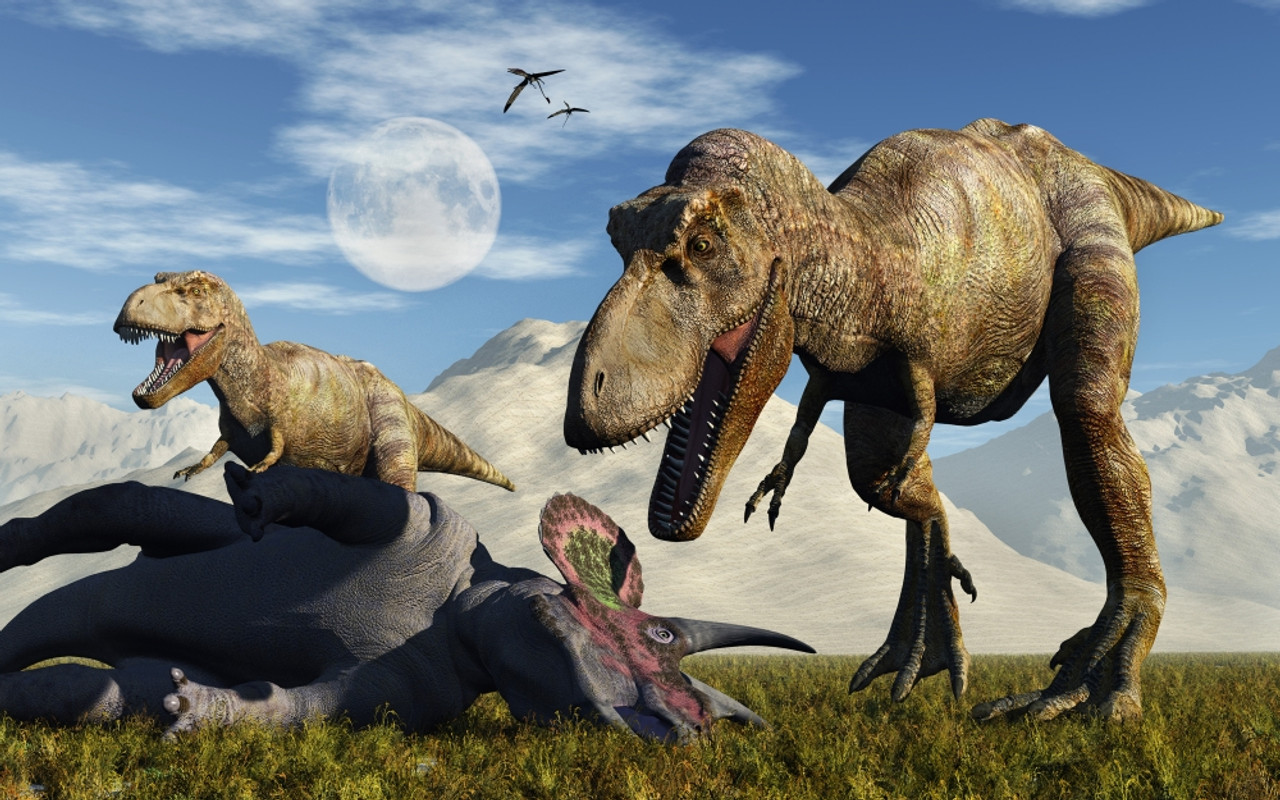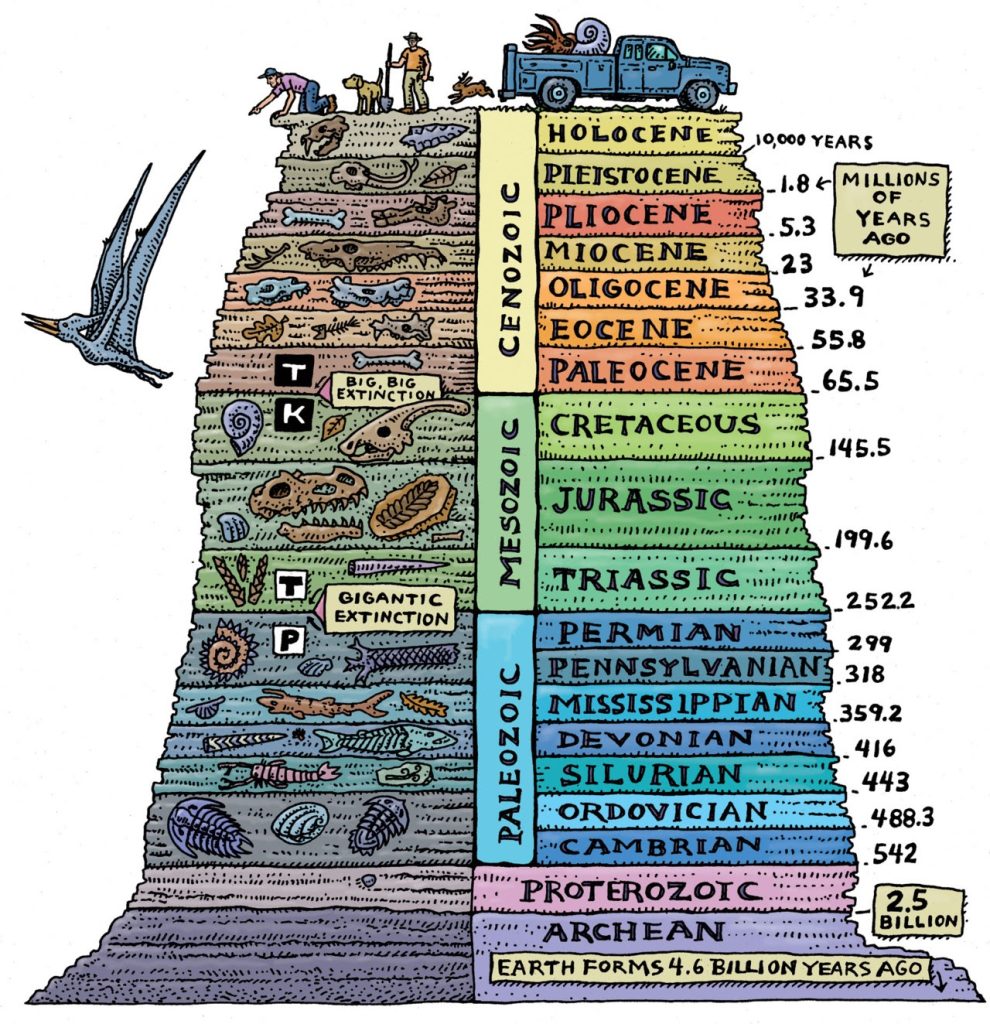Scientists frequently employ terminology like “Mesozoic Era” and “Jurassic Period” when referring to specific periods in the history of the Earth.
The Mesozoic Era and the Jurassic Period both represent stages within the geological time scale.
The geological time scale establishes connections between specific points in Earth’s history and the rock layers formed during those periods in the Earth’s crust.
For instance, the Jurassic Period refers to the period when a specific layer of rock in the Jura Mountains of Europe was being formed.
On this page, you will discover a comprehensive explanation of the geological time scale, including its definition, its users, and its significance…
What Does the Geologic Time Scale Entail?
The geologic time scale serves as a method to measure time based on the layers of rock formed during distinct periods in Earth’s history and the fossils found within each layer. The primary units of the geologic time scale, ranging from the largest to the smallest, are eon, era, period, epoch, and age. Each unit corresponds to the time during which a particular layer of rock was formed.
Since the early days of Earth, rock formations have been steadily accumulating, layer upon layer. These layers act as pages within a historical book, allowing us to glimpse into the events of the distant past.

These rock layers serve as a reference system to determine the ages of fossils found within each layer. If a fossil is discovered in a specific layer—for example, rocks formed during the Jurassic Period—it can be inferred that the species existed during that particular period.
The geologic time scale functions as a timeline and summary of crucial geological and biological events that have occurred on Earth.
An Illustration of the Geologic Time Scale in Practice
The Jurassic Period, well-known due to the movie Jurassic Park, is a prominent period within the geologic time scale.
The Jurassic Period commenced approximately 201 million years ago (Mya) and came to an end around 145 Mya.
During this period, a distinctive layer of limestone was being formed in the Jura Mountains situated in France and Switzerland. The name “Jurassic Period” originates from these mountains.
Based on the fossils found in rocks dating back to the Jurassic Period, paleontologists have determined that dinosaurs became the dominant land animals during this era!
Which Period of the Geologic Time Scale Do We Currently Reside In?
We are presently living in the Meghalayan Age, which falls within the Holocene Epoch of the Quaternary Period within the Cenozoic Era of the Phanerozoic Eon.
D. Chart of the Geologic Time Scale
Below is a simplified representation of the geologic time scale, displaying the eras, periods, and epochs of the Phanerozoic Eon.

Divisions of the Geologic Time Scale
The major divisions of the geologic time scale, listed from largest to smallest, are:
- Eon
- Era
- Period
- Epoch
- Age
Unlike standardized time units such as seconds, hours, and days, the divisions of the geologic time scale are not of equal duration.
Earth’s entire history is categorized into four eons: Hadean, Archean, Proterozoic, and Phanerozoic. The first three eons are collectively referred to as the Precambrian, while the Phanerozoic represents the current eon in which we exist.
To learn more about the Earth’s Precambrian era, you can visit this page: Precambrian Facts.
The Cambrian Period, the initial period within the Phanerozoic Eon, holds great importance as it witnessed a significant event known as the “Cambrian Explosion,” during which numerous new life forms rapidly evolved.
Eons represent vast and diverse time spans in Earth’s history, necessitating their subdivision into smaller intervals for convenience and accuracy. Eons are further divided into eras, which are then subdivided into periods, epochs, and ages.
Currently, we reside in the Meghalayan Age of the Holocene Epoch, which is part of the Quaternary Period within the Cenozoic Era of the Phanerozoic Eon.
The identification of different geologic time categories often relies on the appearance and disappearance of specific types of fossils within rock layers.
For instance, the beginning of the Cretaceous Period is marked by the appearance of fossils belonging to the first flowering plants, as well as early bees and other insect pollinators.
Conversely, the end of the Cretaceous Period is characterized by the sudden disappearance of dinosaurs and numerous other species.
Interestingly, there is a thin layer of sediment containing iridium, a metal found in asteroids, separating the rocks of the Cretaceous Period and the Paleogene Period. This provides evidence that the extinction of large terrestrial dinosaurs was caused by an asteroid impact.
The Importance of the Geologic Time Scale

The geologic history of Earth dates back approximately 4.6 billion years, encompassing an immense expanse of time. To facilitate the study of such vast time frames, geologists and scientists have divided Earth’s geologic history into smaller, manageable units known as the geologic time scale.
The geologic time scale serves as a “calendar” of sorts, documenting the geological events that occurred throughout Earth’s history as recorded in its rock layers.
In the pursuit of studying Earth’s past, geologists and scientists worldwide encountered confusion due to the inconsistent naming of similar rock layers in different regions.
The establishment of the geologic time scale provided a universally recognized standard for measuring and comparing the ages of rocks and fossils.
Thus, if an American scientist discovers a fossil in a Cretaceous rock formation, scientists in other countries can approximate the age of the fossil.
The Invention of the Geologic Time Scale
The geologic time scale was not created by a single individual but rather evolved through centuries of research and experimentation.
One of the early pioneers in understanding rock layers was Nicolaus Steno, a Danish scientist and amateur fossil collector. In the 1660s, Steno published a groundbreaking paper stating that sedimentary rock layers are deposited horizontally over time, with the oldest layers found at the bottom and progressively newer layers on top.
In the late 1700s, William Smith, a British engineer, conducted surveys across the English countryside to identify suitable locations for canal construction. He observed predictable sequences of rock layers in cuttings and noticed that different strata consistently appeared in the same relative positions.
Smith also realized that each stratum could be identified by the fossils it contained. Leveraging this knowledge, Smith compared rock layers in different regions, deducing their approximate ages by examining shared fossil types.
The contributions of early visionaries like Steno and Smith played a significant role in shaping the modern geologic time scale.
The Significance of Fossils in the Geologic Time Scale

Fossils hold tremendous importance within the geologic time scale. Long before the advent of modern dating techniques, scientists relied on fossils to understand Earth’s history and the chronological order of events.
The recognition that specific rock layers can be identified based on their fossil content allows geologists to correlate rock layers between different regions, countries, and even continents.
If rocks from different locations contain the same types or species of fossilized organisms, it suggests that the rocks were formed during the same period.
For example, trilobite fossils are consistently found in rocks dating back to the Cambrian Period of the Paleozoic Era, regardless of their global location.
This knowledge is invaluable in understanding the breakup of continents and their gradual movements to their present positions.
An example highlighting the significance of fossils in correlation is the small dinosaur Lystrosaurus, whose fossils have been discovered in Late Permian rocks in Antarctica, southern Africa, and India. This indicates that during that period, these three landmasses were joined together, as Lystrosaurs could not have traversed large bodies of water.
The Geologic Time Scale and Evolution
The investigation of fossilized remains in rock layers provides scientists with crucial insights into the process of biological evolution.
The oldest and lowest rock strata contain fossils of simple, soft-bodied organisms, while higher layers house fossils of more complex and specialized creatures. The fossil record, preserved within Earth’s rocks over countless eons, portrays the evolution and extinction of various species.
Determining the Ages of Ancient Rocks
While early geologists could establish relative ages of rock strata by comparing the distribution of fossils, determining the exact ages of rocks remained a challenge.
Today, radiometric dating is employed to assign precise ages to Earth’s crust. This technique involves measuring the rate of decay of radioactive elements, such as uranium and potassium, present in the igneous rocks sandwiched between sedimentary layers containing fossils. By analyzing these igneous rocks, scientists can ascertain their ages.
Users of the Geologic Time Scale
A thorough understanding of the geologic time scale is essential for miners who seek specific types or ages of rocks containing valuable minerals.
Farmers may also benefit from knowledge of the age and origin of sediments on their lands, aiding them in choosing suitable crops and locating water sources.
Geologists utilize the geologic time scale to determine the ages of surface rocks worldwide. This knowledge helps them comprehend Earth’s history and interpret geological transformations that may have affected the folding, faulting, or disruption of rock layers.
Paleontologists and other biologists rely on the geologic time scale to enhance their understanding of when species originated, their interactions with contemporaneous organisms, and the timing of their extinctions.
By employing the geologic time scale, paleontologists can reconstruct the gradual evolution of life forms from simple organisms to the emergence of large, complex, and specialized species.
For instance, paleontologist Professor Neil Shubin used the geologic time scale to estimate that in order to discover a fossil of a fish in the process of adapting to land life, he had to search rocks approximately 375 million years old. Utilizing a geologic map, he pinpointed an Arctic island where rocks of this age were exposed and successfully unearthed the fossil fish, which he named Tiktaalik, in 2004.